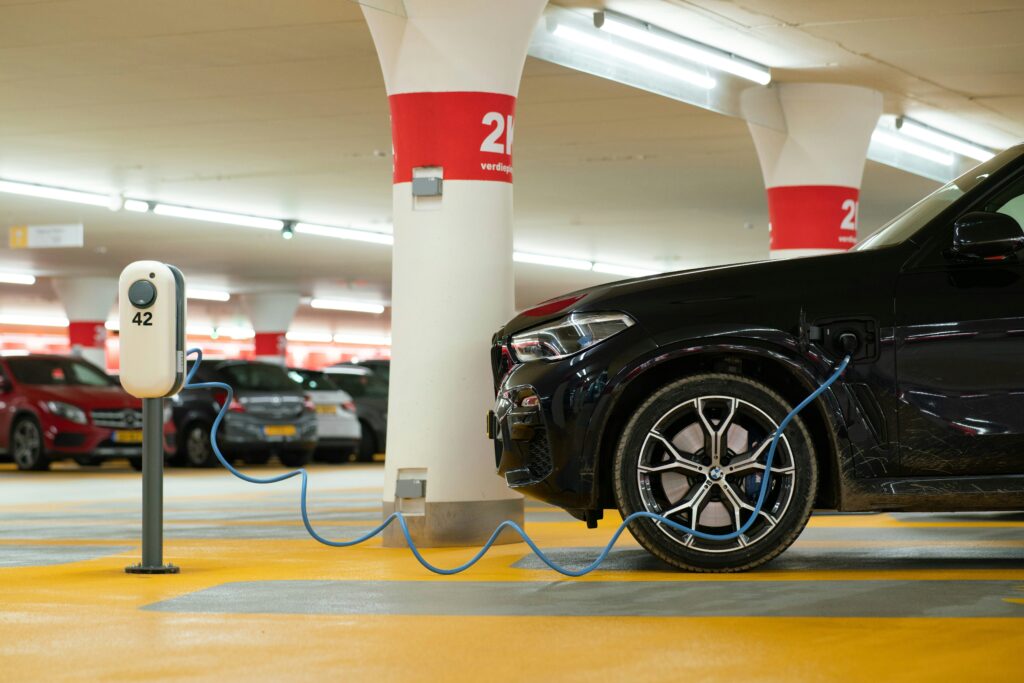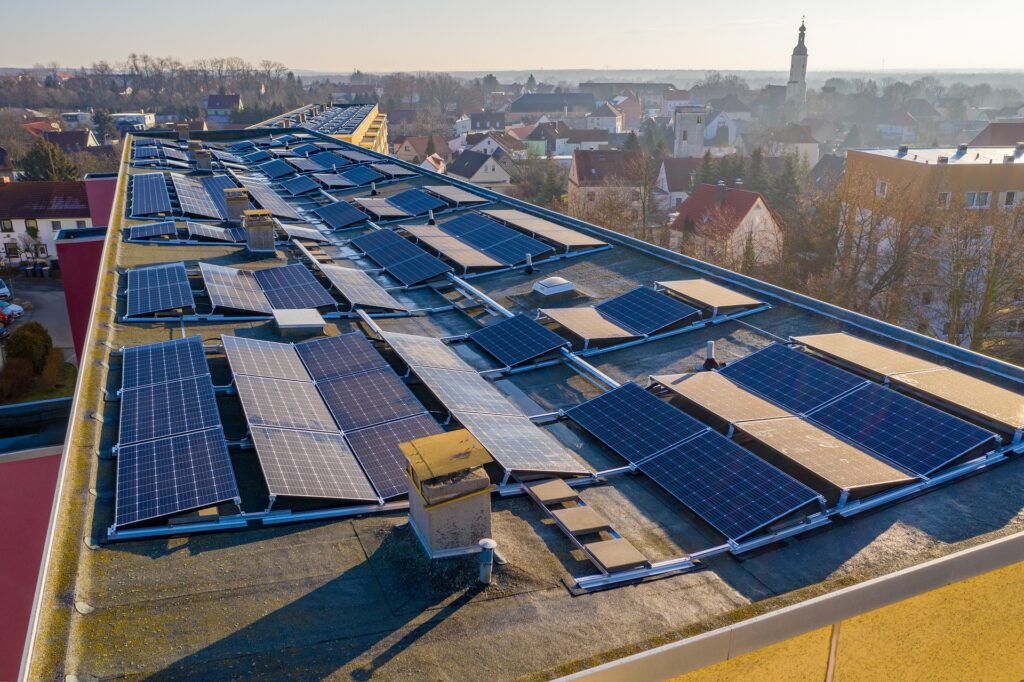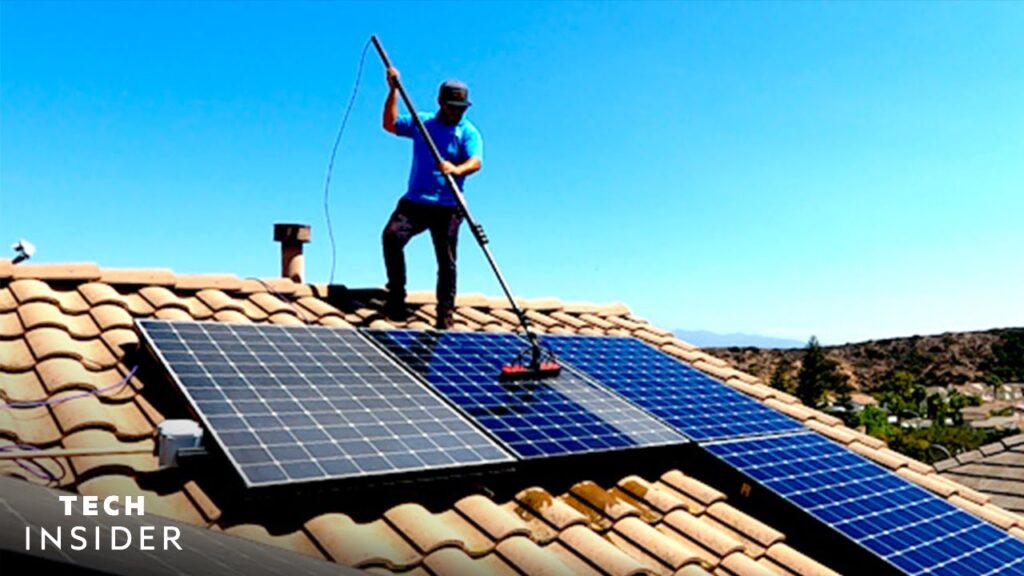To know if a solar panel is charging a battery, check the voltage reading on a multimeter or use a solar charge controller. The former will display the current voltage, indicating the charging status, while the latter will have an LED light indicating whether the battery is charging or not.

To determine if a solar panel is effectively charging a battery, you can follow these steps:
1. Use a Multimeter:
- Measure Voltage:
- Disconnect the solar panel from the battery and measure the open-circuit voltage of the solar panel with a multimeter. The voltage should be close to the panel’s rated output (typically between 17V and 21V for a 12V panel).
- Reconnect the solar panel to the battery and measure the voltage across the battery terminals. If the solar panel is charging the battery, you should see an increase in the battery’s voltage over time.
- Measure Current:
- Set the multimeter to measure current (amperes) and place it in series between the solar panel and the battery. If current is flowing, the solar panel is charging the battery.
2. Observe the Charge Controller:
- Check Indicators:
- Most solar charge controllers have LED indicators or digital displays that show the charging status. A blinking or steady light, or a specific symbol, usually indicates that the battery is charging.
- Monitor Readings:
- If the charge controller has a display, it may show the voltage, current, and sometimes the state of charge (SOC) of the battery. If the readings indicate that current is being sent to the battery, then the solar panel is charging it.
3. Battery Voltage Monitoring:
- Initial and Final Voltage:
- Before connecting the solar panel, measure the battery’s voltage. After the solar panel has been connected for a while, measure the voltage again. If the voltage has increased, the battery is charging.
- Observe Consistent Increases:
- During sunny periods, the battery voltage should rise consistently as the solar panel generates power. If the voltage remains the same or drops, there might be an issue with the charging process.
4. Inspect the Solar Panel’s Output:
- Sunlight Conditions:
- Ensure the solar panel is receiving direct sunlight. The angle and intensity of the sunlight affect how much power the panel generates. On cloudy days, the output may be lower, which could slow down the charging process.
- Panel Connections:
- Check all connections from the solar panel to the charge controller and then to the battery. Loose or corroded connections can prevent effective charging.
5. Check for Battery Indicators (If Available):
- Battery Indicators:
- Some batteries come with built-in charge indicators (like a series of LED lights) that show the charge level. When the solar panel is connected and charging, these indicators should show an increase in charge.
Solar energy has emerged as a sustainable and environmentally friendly alternative to traditional power sources. Harnessing this energy efficiently requires understanding various components of a solar system. One crucial aspect is determining whether a solar panel is effectively charging a battery.
With the help of a multimeter or a solar charge controller, you can easily assess the charging status. Monitoring the voltage reading on a multimeter or observing the LED light on a charge controller will indicate if the battery is being charged or not. By accurately assessing this, solar system owners can ensure optimal performance and effective utilization of renewable energy.
2. Components Of A Solar Panel Charging System
Solar panel charging systems are an environmentally friendly and efficient way to power batteries. Understanding the components of a solar panel charging system is crucial for ensuring it operates effectively. The main components of a solar panel charging system include the solar panels, charge controller, and battery.
A solar panel charging system is composed of several key components that work together to convert sunlight into electricity, regulate the power, and store it for later use. Here are the main components:
1. Solar Panels
- Function: Solar panels are the primary component that converts sunlight into electricity through photovoltaic (PV) cells. They generate direct current (DC) electricity.
- Types: Common types include monocrystalline, polycrystalline, and thin-film solar panels, each with different efficiencies and costs.
2. Charge Controller
- Function: The charge controller regulates the voltage and current coming from the solar panels to the battery. It ensures the battery is charged efficiently without overcharging or discharging too much, which can damage the battery.
- Types:
- PWM (Pulse Width Modulation): This is a simpler, cost-effective type that reduces the voltage to match the battery’s requirements.
- MPPT (Maximum Power Point Tracking): This type is more advanced and efficient, optimizing the power output from the solar panel by adjusting the voltage to ensure maximum power transfer to the battery.
3. Battery
- Function: The battery stores the electricity generated by the solar panels for use when sunlight is not available (e.g., at night or during cloudy weather).
- Types:
- Lead-Acid Batteries: These are commonly used for solar systems due to their reliability and cost-effectiveness, though they are heavy and require maintenance.
- Lithium-Ion Batteries: These are lighter, more efficient, and have a longer lifespan than lead-acid batteries, but they are also more expensive.
4. Inverter
- Function: The inverter converts the DC electricity stored in the battery into alternating current (AC), which is the standard form of electricity used by most household appliances and electronics.
- Types:
- Pure Sine Wave Inverter: Produces a smooth and consistent waveform, making it suitable for sensitive electronics.
- Modified Sine Wave Inverter: Less expensive, but not as smooth, and may not be suitable for all appliances.
5. Wiring and Fuses
- Function: Wiring connects all the components of the system, ensuring the safe and efficient transfer of electricity. Fuses are used to protect the system from overcurrent, which could cause damage or fire.
- Components: Includes cables, connectors, circuit breakers, and fuses, all of which are crucial for safely distributing power and protecting the system.
6. Mounting and Racking System
- Function: The mounting system securely holds the solar panels in place, typically on a roof or the ground, ensuring they are angled correctly to maximize sunlight exposure.
- Types:
- Roof Mounts: Common for residential systems, designed to integrate with different types of roofing materials.
- Ground Mounts: Used when roof space is limited or for larger installations; allows for easier maintenance and optimal panel positioning.
7. Monitoring System (Optional)
- Function: A monitoring system tracks the performance of the solar panel system, providing real-time data on power generation, battery charge levels, and system efficiency.
- Types:
- Basic Monitors: Display simple metrics like voltage and current.
- Advanced Monitors: Offer detailed data, remote monitoring, and sometimes control over the system.
Solar Panels
Solar panels are the core component of a solar panel charging system. They consist of photovoltaic cells that convert sunlight into electricity. When sunlight hits the solar panels, it generates a direct current (DC) which is then used to charge the battery. The size and efficiency of the solar panels determine the amount of electricity they can generate.
Charge Controller
A charge controller is an essential component that regulates the flow of electricity from the solar panels to the battery. It prevents overcharging and discharging of the battery, ensuring its longevity and optimal performance. The charge controller also helps to maximize the charging efficiency, especially in varying light conditions.
Battery
The battery stores the electricity generated by the solar panels and provides power when the panels are not producing electricity, such as during the night or on cloudy days. It is important to select the right type and capacity of battery based on the energy requirements and charging system specifications.

3. Indicators Of A Charging Solar Panel
The charging indicators of a solar panel provide clear signs that it is effectively charging a battery. By looking for signals such as LED lights, voltage readings, and ampere meters, you can easily determine if your solar panel is functioning and charging your battery efficiently.
When it comes to monitoring the charging process of a solar panel, there are several indicators that can provide valuable information. These indicators help us understand whether the solar panel is effectively charging the battery or not. Let’s explore these indicators below:
3.1 Voltage Output
Voltage output is an important indicator of a charging solar panel. It measures the electrical potential difference between two points, in this case, the solar panel and the battery. Higher voltage output indicates a stronger charging process. You can measure the voltage output using a digital multimeter, which will display the reading in volts (V).
3.2 Current Output
Current output refers to the flow of electrical charge from the solar panel to the battery. Measured in amperes (A), it represents the rate at which the battery is being charged. The higher the current output, the faster the charging process. You can measure the current output by connecting a multimeter in series with the circuit.
3.3 Charge Controller Led
Charge controller LED is a useful component that indicates the status of the charging process. It usually comes with different colored LEDs, each representing a specific status. For example, a green LED might indicate that the solar panel is charging the battery, while a red LED could mean that the battery is fully charged or there’s an issue with the charging system. Make sure to refer to the product manual to understand the specific LED indications.
3.4 Battery Voltage
Battery voltage is another factor that can give you insights into the charging status. Keep in mind that a fully charged battery typically has a higher voltage, while a discharged battery will have a lower voltage. By monitoring the battery voltage, you can assess whether the charging process is taking place or if the battery requires maintenance or replacement.
In summary, understanding the indicators of a charging solar panel is crucial to ensure the efficiency and effectiveness of your solar power system. By monitoring the voltage and current output, paying attention to the charge controller LED, and monitoring the battery voltage, you can ensure that your solar panel is charging the battery optimally.
To know if a solar panel is charging a battery, use a multimeter to measure voltage and current, check the charge controller’s indicators, monitor the battery’s voltage over time, and ensure the solar panel is receiving adequate sunlight. These steps will help confirm that the charging process is working as expected.
4. Testing The Charging Process
Once you have set up your solar panel and battery system, it is important to ensure that the solar panel is effectively charging the battery. There are several ways to test the charging process and make sure everything is working correctly.
4.1 Using A Multimeter
One of the most accurate ways to determine if a solar panel is charging a battery is by using a multimeter. This device measures the current and voltage flowing through the system. To use a multimeter, follow these steps:
- Set the multimeter to measure DC current.
- Connect the positive probe of the multimeter to the positive terminal of the solar panel.
- Connect the negative probe of the multimeter to the negative terminal of the solar panel.
- Observe the reading on the multimeter. If there is a positive current, it means the solar panel is charging the battery.
4.2 Observing The Charge Controller
If your solar panel system is equipped with a charge controller, you can monitor its status to determine if the battery is being charged. The charge controller typically has indicators or a display that show the charging status, such as “charging” or “float”. If the indicator shows that the battery is being charged, it means the solar panel is doing its job.
4.3 Checking Battery Voltage
Another way to determine if a solar panel is charging a battery is by checking the battery voltage. When the battery is being charged, its voltage level will increase. To check the battery voltage, follow these steps:
- Use a voltmeter to measure the voltage across the battery terminals.
- Compare the measured voltage with the manufacturer’s recommended charging voltage range. If the measured voltage is within this range, it indicates that the solar panel is charging the battery effectively.
4.4 Monitoring Power Generation
Lastly, you can monitor the power generation of the solar panel system to determine if the battery is being charged. Keep an eye on the power output of the solar panel. If the power output is consistent and sufficient, it means the solar panel is successfully charging the battery.

5. Factors Affecting Solar Panel Charging
When it comes to ensuring that a solar panel is effectively charging a battery, there are several important factors that can impact its performance. Understanding these factors is crucial for optimizing the charging process and ensuring the efficiency of the solar panel system.
5.1 Sunlight Intensity
Sunlight intensity plays a vital role in determining the charging capacity of a solar panel. High sunlight intensity results in greater energy production, leading to faster and more effective battery charging.
5.2 Shade Or Obstructions
Shade or obstructions, such as tall buildings or trees, can significantly reduce the amount of sunlight reaching the solar panel. This obstruction lowers the panel’s charging capacity, impacting the battery charging process negatively.
5.3 Panel Orientation
The orientation of the solar panel also influences its charging efficiency. Proper alignment towards the sun ensures maximum exposure to sunlight, resulting in optimal battery charging performance.
5.4 Weather Conditions
Weather conditions, such as cloudy or overcast skies, can reduce sunlight intensity and subsequently impact the solar panel’s charging ability. Monitoring weather patterns is essential for understanding their impact on battery charging.
5.5 System Efficiency
The overall system efficiency, including the quality of the solar panel, charge controller, and battery, directly affects the charging process. A well-designed and maintained system ensures maximum charging efficiency.
6. Troubleshooting Common Issues
While solar panels are generally reliable and efficient, there may be instances when you encounter issues with charging your battery. Fortunately, most of these problems can be easily resolved with a few troubleshooting steps. Let’s take a look at some of the common issues you might face and how to tackle them. Know If a Solar Panel is Charging.
6.1 Faulty Connections
If your solar panel is not charging the battery, the first thing to check is the connections. Ensure that all the cables and wires are securely connected and that there are no loose or damaged components. Sometimes, a simple reconnection can resolve the issue and restore the charging process. Know If a Solar Panel is Charging.
6.2 Defective Charge Controller
The charge controller is an essential component that regulates the amount of charge going into the battery. If you suspect that your solar panel is not charging the battery, it’s worth checking if the charge controller is working correctly. Inspect the controller for any visible damage or loose connections. If necessary, consider replacing the charge controller with a new one.
6.3 Battery Problems
In some cases, the issue may not lie with the solar panel or charge controller, but with the battery itself. Check the battery terminals for corrosion or buildup that could disrupt the charging process. Clean the terminals if needed and ensure a secure connection. If the battery is old or damaged, it might be time to invest in a new one to ensure optimal charging performance.
6.4 Insufficient Sunlight
The amount of sunlight directly affects the charging capability of your solar panel. If you notice that the battery is not charging, consider the position and placement of your panel. Ensure that it is receiving ample sunlight throughout the day, free from any obstruction that could reduce its efficiency. Sometimes, a simple adjustment to the panel’s angle or location can significantly improve its charging capacity.

Credit: community.ring.com https://solarivr.com/2024/05/25/how-to-fix-solar-panel/ Know If a Solar Panel is Charging
Frequently Asked Questions For How Do You Know If A Solar Panel Is Charging A Battery
How Can You Tell If A Solar Panel Is Charging A Battery?
You can tell if a solar panel is charging a battery by checking the voltage being generated and the charging status on the battery monitor.
What Are The Signs That A Solar Panel Is Charging A Battery?
Signs that a solar panel is charging a battery include an increase in voltage, the battery charge controller showing a charging status, and the battery’s state of charge gradually increasing.
How Long Does It Take For A Solar Panel To Charge A Battery?
The time it takes for a solar panel to charge a battery depends on various factors such as the panel’s wattage, sunlight intensity, battery capacity, and the charging efficiency. It typically ranges from a few hours to a couple of days.
Conclusion
To sum up, monitoring the voltage and current output is an effective way to determine if a solar panel is charging a battery. By using a multimeter, you can easily assess the charging process and ensure optimal performance. Regular maintenance and proper connections are also crucial for efficient solar panel charging.
Understanding these key indicators can help you maximize the benefits of solar power.